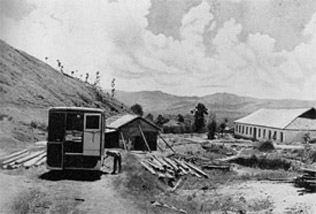From their arrival in China the Unit had participated in a variety of social and economic rehabilitation initiatives. Andrew Braid soon became attached to the Chinese Industrial Cooperatives organisation and joined the Ballie School in Shuang–Shih-p’u. Laurie Baker single-handedly took on the running of the leper hospital which had been established by German Missionaries at Pichieh who, as enemy aliens, had been forbidden to stray outside their nearby mission station.
This rehabilitation work became more prominent post-1946, focused largely on seeking to re-establish China’s battered hospital and public health infrastructure. It also expanded into other areas of activity. A major project was undertaken in the formerly occupied province of Honan. Here the ravages of war had been exacerbated by the Chinese destruction of the levees on the Yellow River in 1938 in an attempt to halt the Japanese advance. This had engulfed many towns and cities and large areas of farmland, displacing millions of people from their homes and livelihoods and exacerbating the already widespread shortage of food.
Other reconstruction work involved the establishment of agricultural initiatives notably in animal husbandry and introducing new concepts of crop rotation. One such project involved the utilisation of the hydraulic landing gear salvaged from a Liberator aeroplane in a peanut crushing plant.
After 1945 much of this work was supported by the newly formed United Nations Relief and Rehabilitation Administration, but was compromised as a consequence of western refusal to recognise the Communist Government after the Civil War. The new Government’s increasing ability to undertake work formerly done by the China Convoy meant their presence became increasingly incongruous. In early 1951 its operations were finally wound up, with only Peter Townshend staying on to continue his work with the Chinese Industrial Co-operatives.

Reconstruction work became a central role for the China Convoy.

 FAU China Convoy Reunion Group
FAU China Convoy Reunion Group